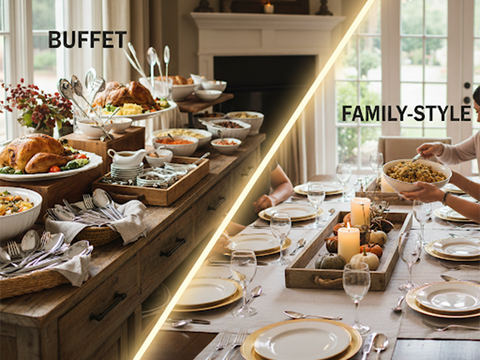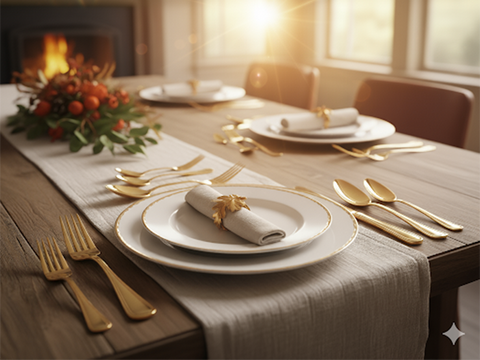For a host, the countdown to Thanksgiving is always about more than just days - it's about decisions. The menu has been planned, the guest list has been confirmed. Now the important logistical question still remains: How will you deliver your meal? The mere option of a blessed grand, flowing buffet or the traditional feeling of family style service will define the experience of your Thanksgiving dinner. It is the difference between establishing the vibe, determining the flow, or even deciding if you will pre-set the exquisite dessert spoon above the plate or place it with dessert on the buffet, etc. It really is the key to a seamless, joyful celebration.
The Great Debate for a host is Thanksgiving dinner service: a grand, flowing buffet, or the traditional, intimate feeling of family style?
There are no particularly correct or incorrect answers, only the one that is correct for your home, your guests, and your vision. This guide will explore the Pros and Cons and approach to elegant delivery of both buffet style and family style, allowing you to plan for your memorable feast and celebration in the most seamless manner possible.
Buffet: Elegant, Efficient, & Abundant
Though the term "buffet" may bring to mind long queues like those at a cafeteria, a thoughtfully executed buffet is an art form and a spectacular sight to behold. An outstanding buffet is a gorgeous and flowing expanse of food that engages guests to socialize and formulate their own culinary experiences.
The Pros:
- Space Saver: A buffet's greatest advantage is providing you with a completely open dining room table, allowing room for elaborate center pieces, candles, and a fuller and less cluttered dining table setting for your guests.
- Guest Flow: A buffet invites guests to get up and walk around, which encourages socialization during meals with guests that aren't seated immediately next to each other.
- Easy Replenishing: It is easy to replenish empty platters and bowls with hot fresh platters from the kitchen without having to break up the conversation at the main table.
- Dietary Needs: A buffet is generally easier for all guests (and host) if there are dietary restrictions and needs. You can be a good host and include small beautiful labels creating ease of use for guests with dietary restrictions (Ex. Gluten Free, Vegan, Contains Nuts)
The Cons:
- During the reservation process, you must make sure you have an appropriate, accessible placing area (sideboard, kitchen island, console, small table) to stage your items.
- With a larger group some "traffic jam" will develop if you aren't organized.
- Less formal. Some traditionalists may feel that getting up to serve yourself is not as formal as plated meals.
How to Make It Elegant

The Secret To A Five-Star Buffet Is In The Presentation
- Develop a Logical Order: Sequence matters. Your line should begin with the plates. The next step will be the mains (turkey, ham), as you'll find it easier if the side items (stuffing, potatoes, vegetables) follow logically; and then smaller things (gravy, cranberry sauce, and rolls) finish off the line.
- Unifying the Buffet: The single best way to elevate your buffet is to serve in a unified set of serveware. When you offer a buffet that includes serveware that coordinates or is complementary, it looks planned, plentiful, and very classy.
- Every Dish Gets a Tool: A cardinal rule of elegant hosting: every single dish needs a serving utensil. A beautiful buffet can go off the rails when you find your group scrounging around for that clean spoon. Just prepare a full serving tool collection. Most of the time, you'll want multiple serving spoons to serve stuffing, potatoes, and veggies, as well as tongs when serving a salad. It's a small detail, yet it feels ultra-professional.
- Don't Juggle Flatware: Don't make your guests juggle their utensils. The best way to present your sets is to roll your flatware set in linen napkins, tie them with a simple ribbon or jute string, and place in a basket or tray at the end of the buffet line.
- Use Height: A flat table is a boring table. Create visual interest by using cake stands or sturdy, cloth-draped boxes to elevate a few key dishes, like the main platter.
Family Style: Intimate, Traditional & Warm
This is the iconic image of "Norman Rockwell" Thanksgiving: a table full of lovely dishes, guests passing platters, pouring gravy, and sharing together- it is intimate, enjoyable, and it feels warm.
The Pros:
- Profoundly Traditional: This style creates a strong sense of warmth, nostalgia, and “togetherness”. Passing a dish is a gesture of sharing.
- Facilitates Conversational Interactions: It prompts conversations quite naturally, as an example, "can you pass the mashed potatoes?" prompts interaction among guests.
- Intimate Essence: Everyone is more or less seated together, thus it feels as a single and shared intimate occasion.
The Cons:
- Table Traffic Jam: This is the most significant challenge. When a table gets crowded, it can feel chaotic or messy, and there is hardly enough space for water glasses, let alone decorations.
- Awkward for Some: It can be physically awkward for guests at the thought of the table, or for children to handle heavy, hot platters.
- Heat Loss: Dishes typically will get cold more quickly while being passed among guests at the table.
How to Make It Elegant
The secret to a successful family-style meal is strategic organization and curation.
- Arrange the Table: You don't necessarily need to put out all 15 dishes on the table at once. Leave a few "refills" on a sideboard. Think of the main table as holding the essentials: the turkey, stuffing, potatoes, a green vegetable, and gravy.
- Combine Small Items: This is the ultimate pro-hosting tip to save space. Try not to have all three small, separate bowls of gravy, cranberry sauce, and butter on the table at once. Instead, group or combine them. For example, if you place them in a lovely wooden serving tray, you will eliminate the need for three small dishes, and it will be much easier if you have them all together and can pass one item in an easier fashion.
- Protect and Serve with Style: A hot casserole dish being passed around the table can be awkward to pass, and it can hurt your table. When you use sturdy wooden trays with handles to transport the prepared casseroles from the kitchen you will not only protect your table (or floor), but it also adds to your rustic, artisanal touch that is great for the Thanksgiving aesthetic. The handles make it safer and easier to pass casserole dishes from person to person.
-
Pre-Set Everything: The success of this style emerges from being organized. Make sure the entire dinner table is set, with flatware, glassware, and napkins ready to go, before all the food arrives. This begins the essential structure and border that will be created by the serving dishes when they arrive at the table.

The Hybrid Approach
For many hosts, the ideal answer is somewhere in between. The hybrid style allows for the closeness of a family-style meal with the space-saving advantages of a buffet.
Here’s how it works:
- Prepare the table for a family-style meal with all the additional side dishes, stuffing, potatoes, casseroles, and vegetables displayed and letting the guests pass it around to create a warm, communal vibe.
- Make a "Station" on the sideboard for the two biggest space-takers: the turkey and the drinks. The turkey can be presented and/or carved on a sideboard for guests to either be served or come up to get their main protein. Plus, it keeps the (potentially messy) carving off the main table.
This method keeps the dining table from becoming overwhelmingly crowded but preserves that cherished tradition of passing and sharing.
Which Style is Right for Your Thanksgiving?
The reality is that there is no right or wrong answer. The best serving style for your Thanksgiving meal is the one that relieves stress and increases joy.
- Choose BUFFET if: You have a large group, a small dining table, or you want to foster guests intermingling.
- Choose FAMILY STYLE if: You have a small group, a large table, and have a yearning for the "passing-the-platter" feeling that is classic, old-fashioned, and intimate.
- Choose HYBRID if: You want the intimacy of a family style meal, but don't have a table big enough to serve a 20-pound turkey.
Ultimately, it's up to you: It doesn't matter which serving style you use, if dinner is a success, and it will be if the host is friendly and the food has been thoughtfully prepared. With the right serving tools, whether that means coordinating sets of serving utensils for a beautiful buffet, or a smooth constructed wooden tray used for family-style service, the goal is to extend an enjoyable, graceful, and gratitude-inducing feast for everyone.
Frequently Asked Questions (FAQs)
Q: What’s the correct number of serving spoons for Thanksgiving?
A: Our guiding principle is that you need one dedicated utensil, which could be a serving spoon, for each and every item on the table. I can’t imagine having too many serving spoons! For an average Thanksgiving meal, I would guess you need 4-5 decent-quality serving spoons for your casseroles and sides, not counting any tongs, ladles, or forks (or spoons!) we could use.
Q: My dining table is small, but I really don’t like the idea of a buffet. What can I do?
A: This is the perfect case for the Hybrid Approach. Serve all your side dishes family-style, but set the turkey, drinks, and even dessert on a sideboard, kitchen counter, or bar cart. This gives you 50% of your table back to make dinner feel more intimate and not crowded. This is also a perfect place to lay out the coffee cups and the dessert spoon for each of the guests, so your main dinner table can stay clear until the last course is served.
Q: What ways are there to keep food warm at a buffet?
A: Liquids, such as gravy, can be kept warm in thermal carafes. If you're serving solid foods, warm your serving platters in a low oven (around 200°F or 90°C) for a few minutes before putting the food on them. If you are serving a bigger crowd, an electric warming tray is a good investment. Lastly, don't put out all the food at once, instead keep replenishing the food in smaller batches, fresh from the kitchen.



